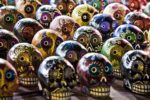You may have noticed a flood of sugar skulls and marigolds emerging in fall decorations and school crafts or assignments. Previously, it seemed that pumpkins, ghosts, and the occasional skeletons ruled the roost when it came to October. Now, walking through school hallways, store aisles, and even yard displays, representations from Día de los Muertos are everywhere. So why this emergence? What’s the deal with Día de los Muertos (Day of the Dead)?
A Brief Introduction to Día de los Muertos
Origins of Día de los Muertos go all the way back to ancient indigenous Aztec traditions. When Spanish explorers arrived in the region of Mexico, they brought with them Catholic traditions of All Saints Day and All Souls Day. As is the case with many customs, Día de los Muertos combines traditions from more than one culture—a convergence of both Aztec and Catholic commemorations of the dead. It occurs November 1 and 2 and is considered a celebration of life rather than a somber occasion.
Participants create altars (altares de muertos), either at cemeteries or in their homes, decorated with remembrances or offerings (ofrendas) of their loved ones, including pictures, personal items, and favorite foods. The belief is that these deceased loved ones will visit them because they are attracted by the bright marigold flowers, colorful decorations, and delicious food. These two days are spent first honoring the lost children (angelitos) and then the departed adults. Día de los Muertos is celebrated everywhere in Mexico but has spread into the United States and many other countries as well.
Why Day of the Dead Is So Popular
Day of the Dead festivities have an overall sense of merriment with a macabre sense of humor. The bright colors of the altar decorations, the good food, and the party-like celebration of life appeal to many, even outside of the traditional cultural heritage. The timing of Día de los Muertos as being so close to Halloween makes the amalgamation of death, costumes, and partying an easy addition to fall festivities.
Also, in 2008, the United Nations Educational, Scientific, and Cultural Organization (UNESCO) added Día de los Muertos to their Intangible Cultural Heritage listing, providing an additional international spotlight on this tradition. In 2014, 20th Century Fox released the animated movie The Book of Life; and in 2017, Disney-Pixar’s Coco again created an animated and fantastical representation of Día de los Muertos. Both of these movies sparked an interest in and attraction toward the celebrations and cultural beliefs surrounding Day of the Dead.
School Celebrations of Día de los Muertos
Since ornate and colorfully decorated sugar skulls and costumes are fun to imitate, many schools have taken to teaching this cultural celebration as a part of their art or classroom lesson plans. These school activities range from decorating sugar skulls and creating offerings (photos and memorabilia) all the way to asking students to build altars to their loved ones.
This has created some controversy in the parent community as students are participating in Day of the Dead activities as part of their classroom assignments. Many parents object for religious reasons to their kids’ required involvement and/or do not like their children focusing on death. Supporters, however, view this as educating and teaching children about other cultures and as no different than activities and crafts for other cultural celebrations/holidays taught in school.
What are your thoughts on Día de los Muertos being taught in schools? Has your child brought home any sugar skulls or other Day of the Dead crafts or assignments? Does your family participate yearly in Día de los Muertos festivities as a part of your family traditions? Comment below with your thoughts—we’d love to hear from you!






































